Updated 03/24/2024: Are you a new puppy parent looking to train your new bundle of joy? Those adorable fur-babies are great to have around until you realize that they come to you untrained. While teaching them their name and how to sit on command are all very important, one of the first things a new puppy owner wants to know is how to potty train a puppy…..fast. Potty training a puppy doesn’t have to be hard or take a long time. You just need to know the secrets to fast training.
In our guide “Potty Training a Puppy: Made Easy” we will show you how we potty trained our puppy in three weeks.
For many people, teaching their puppy not to go in the house seems close to impossible. But in reality, potty training a puppy is pretty easy. All you need to do is follow their natural instincts.
Puppies naturally want to keep their space clean. This means they will look for an area away from where they sleep and play to eliminate. They also do best when they follow a routine. Much like human children.
By using this knowledge, along with a few tricks I have learned over the years, you can make potty training your puppy a snap.
Join us, I will show you the tricks and tips that we used to make potty training a puppy quick and easy.
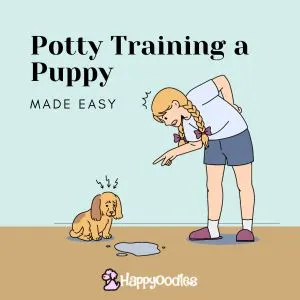
Warming:
Puppies who are not fully vaccinated should not be brought to public areas where other unknown dogs might have been. This means not everything in this guide may work for you or that you need to wait until it is safe for them. We have a private yard where no other dogs besides our own have been.
The Puppy Blues – Dealing with a new puppy can be hard, especially if you are a first-time puppy parent. You might even feel like you made a mistake by getting a puppy. But it does get better. Check out my post on Puppy Blues: Dealing with Regret to see how I managed my own puppy blues.
Tips and Tricks for Potty Training a Puppy
Tip #1 – Dogs follow the scent
Most dogs want to go where other dogs have already gone. But if you have a puppy that is not completely vaccinated you don’t want to take them someplace where other unknown dogs are. You need to be careful.
In our case we had a private backyard with a dedicated potty spot. To get them used to going in one area, take them there when you first bring them home whether it is a private yard or a pee pad in your home. Wait until they go before doing anything else.
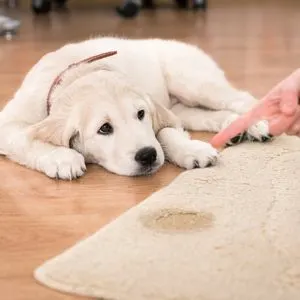
Tip # 2 – Create a dedicated potty spot
As I already mentioned we have a dedicated potty spot in our yard. I highly recommend that you do too. A dedicated potty spot can accomplish a few things.
- Keeps the rest of your yard poop free
- Makes it easier to clean up the poop
- Teaches your puppy to take care of business when they are in that spot
Never play with your puppy in the potty spot. Play time should take place somewhere else.
For ideas and tips on how to create a dedicated potty spot check out our post: Dog Potty Area Guide: Tips and Ideas
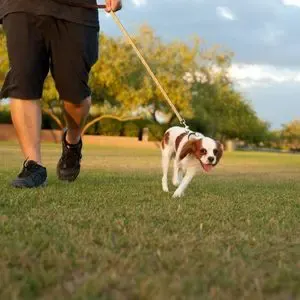
Tip # 3 – Take time off to train your puppy
Plan to take time off from work in order to focus on your new puppy. Not only will this time allow you to work on potty training a puppy, but it will also give you time to bond with your puppy. A puppy that is left home alone will not be able to learn the rules of the house from you.
Tip # 4 – Create a schedule
Our new puppy Bella had a few accidents in the house in the beginning. The accidents happened when we lost track of time and were not watching her as carefully as we should have. By creating a schedule and sticking to it you will remember to take them out every couple of hours.
Everyone’s schedule will look different. But when creating your schedule here are a few things to keep in mind. Puppies should be taken out for a potty break:
- When they get up in the morning
- 10 to 15 minutes after they eat or drink
- Before and after naps
- At night before going to bed
- After extended play times
- Anytime that they are taken out of their crate or playpen.
Now look at the schedule. Are there any times that go beyond two hours? If there is, schedule a few more potty breaks so you never go more than two hours in between. At least in the beginning. Of course if you still have accidents make the time between potty breaks shorter. As your puppy matures they will be able to hold it longer so you should gradually increase the time between potty breaks.
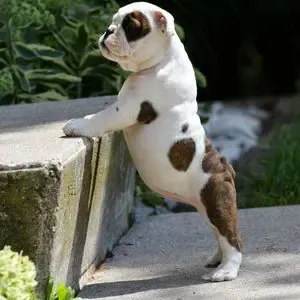
Tip # 5 – Limit Where They Can Roam
When puppy training, it’s important to limit where they can roam. Puppy’s should not be given free range of the home. Instead limit their area to one room or a gated play area, when they cannot be watched.
Tip # 6 – Pay Attention
Make sure to pay attention to your puppy. This will help you to learn the signs that they need to go. And there are signs, but more on that in the next tip.
One of the recommended ways to keep track of your puppy is to keep them on a leash at all times and attach the leash to you. This way your puppy will never be more than a few feet away.
While this may work it wasn’t something I could see myself doing. Instead we kept her gated in our small kitchen. That way I could keep my eye on her even as I was taking care of other stuff.
I also didn’t want her to develop separation anxiety. I wondered if having my puppy attached to me all the time would cause her not to want to be alone.
Being comfortable with being alone is an important life lesson that a puppy needs to learn. Please read my post on how to prevent separation anxiety in puppies to learn more.
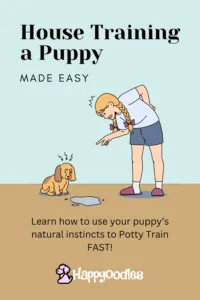
Tip #7 – Learn the signs that indicate they need to go
Our Golden Retriever rescue, Charlie would go downstairs to the back door and bark whenever he needed to go out. Our English Springer Spaniel Molly was a quiet dog. She would go to the back door and wait. Sometimes she would whine.
Bella just goes to the back door and stares at it. If we don’t notice she will eventually tell us by crying but most of the time she is hard to miss standing in front of the door. All dogs will eventually learn to tell you when they need to go out, but when they are a puppy they don’t yet know how to tell you. This is why you need to learn their signs.
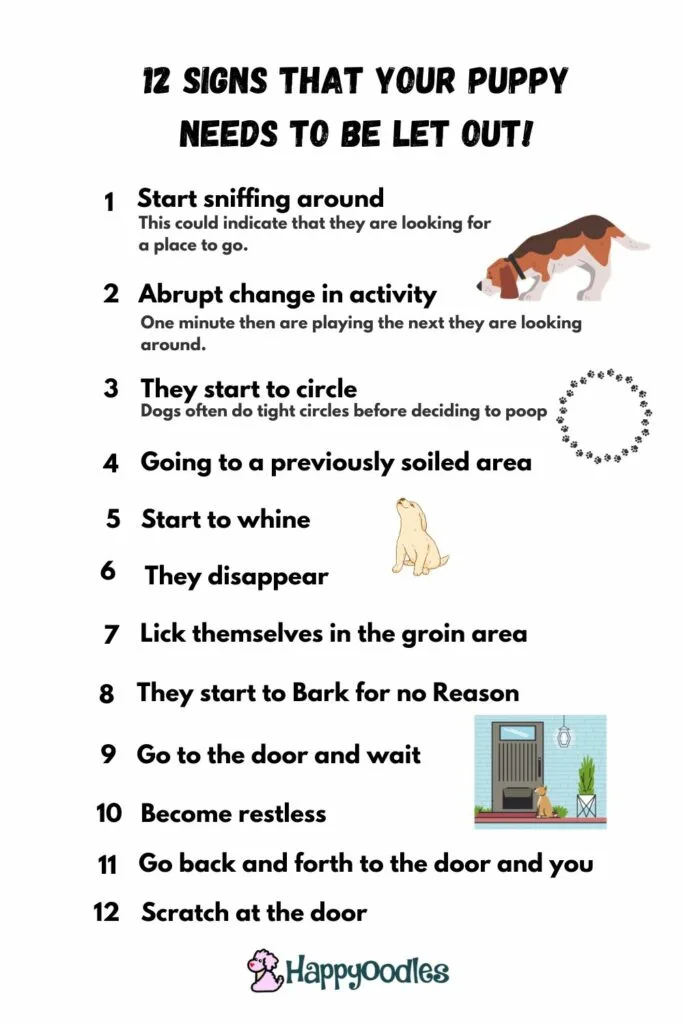
Tip# 8 – Limit the use of Puppy Pee Pads
In the original post I said that I thought it was a mistake to use pee pads for a puppy. I felt it was confusing our puppy when we were using them. One minute she was being praised for going on the pad in the house, the next she was told to go outside.
But then one of our readers pointed out that taking your puppy to go out to the bathroom before they were completely vaccinated could unnecessarily expose them to Parvo or other diseases.
They are completely right. Especially if you need to take them to a public area. As I mentioned above this is how we potty trained our puppy, but we also have a private backyard. What worked for us may not work for everyone.
I still think the use of pee pads can be confusing for a puppy, but as the reader pointed out, a few accidents is not worth the life of your puppy.
I think the next best thing to do is limit the use of pee pads to one area. If possible, place them close to an outside door, so they learn to go to the door when they need to potty. Of course you need to make sure they are easily accessible to your puppy throughout the day.

Tip# 9 – Getting them to go when outside
A typical complaint people have when potty training a puppy is that the puppy goes inside the house right after they are outside. There are a few issues that might cause this.
- If the dog is allowed to use puppy pads they may assume that going in the house is what you want them to do
- It may be that the puppy was not ready to go when they were outside
- Or it could be that they were distracted when they were outside
It is important to give your puppy time to walk around for a while. Exercise helps get a puppy’s digestive system moving. The trick is to give them some exercise but to get them back to the potty spot before they are ready to go. To master this you will need to pay careful attention to their potty signs.
Just remember to limit where they walk until after they are fully vaccinated.
Tip# 10 – Use Positive Reinforcement
The easiest way to teach your puppy anything is with positive reinforcement. Whenever your puppy goes to the potty in the right spot reward them immediately. This can be in the form of verbal praise in a happy voice, physical praise by petting them or playing with them or by giving them treats. For many dogs high value treats work the best.
I also believe it is important for dogs to know when they did something wrong. If you catch your puppy going in the house, it is ok to tell them no in a stern voice.
Tip # 11 – Learn the proper way to use a crate when potty training a puppy
I often hear people say they are crate training to potty train a puppy. Crate training and potty training are not the same thing. When you crate train you are teaching a puppy to be comfortable in an enclosed space. This is important if you want to travel with your dog or if they ever need to stay at a veterinarian’s office. Potty training is teaching your puppy to go to the bathroom in a preferred place.
You can’t potty train a puppy if they are always in the crate. Yes, they won’t go inside their crate but that doesn’t mean you are teaching them not to go in the house when they are out of the crate. They have to be out of the crate to understand that they shouldn’t pee in the house.
The only time a puppy should be crated is when you are unable to watch them during the day or at night when you are sleeping. If you are unable to use gates to keep them close consider using an exercise pen to keep them nearby and contained.
To learn more about how to crate train your puppy read our posts Crate Training a Puppy – Made Easy and How to Crate Train a Puppy: 10 Mistakes to Avoid
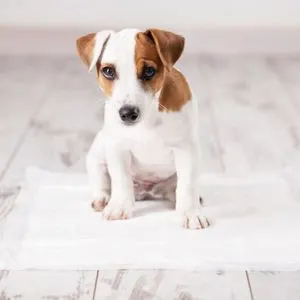
Tip# 12 – Clean up accidents completely
Like I said in tip #1 dogs prefer to go to the bathroom where there are potty scents already. This means if they had an accident in your home they will want to return to that area the next time too. So it is really important to thoroughly clean up the accident area.

Becky Bruns
Friday 25th of March 2022
Best post ever. Like you I had had older dogs and literally couldn't remember what happened the last time I had a puppy but I assure you it wasn't perfect. I used your tip about moving old poo to the new spot and bingo, it worked in under a minute despite cold and rain and 12 week old puppy. We are building a new enclosure tomorrow and ready to GET HER TRAINED. Whatever anyone else does - START. FROM. DAY. ONE. have your plan and your puppy place planned and ready before the puppy comes home.
Sweet Purrfections
Tuesday 23rd of June 2020
Great hints and tips! It's been 40+ years since I had to help potty train a puppy. I'm not sure I'd have the patience to do it now. At least my cats were already litter box trained when they came to ive with me.,
Becky Bruns
Friday 25th of March 2022
@Sweet Purrfections, Oh yes! I'm 71 and was in bad "puppy blues" before I read these posts. Now I am sure I'll have the patience. And my Liberty is a special friend/project in the making.
Nancy
Monday 22nd of June 2020
Great tips! I puppy-sat for my son's doodle recently and we had zero problems I am happy to share. Mostly I headed off issues by taking the darling out before bed and just frequently, but she did come to me sort of whining once and I thought, "maybe she has to go out!" Well, she did! Success. Seems really listening to them helps as they progress.
Emilia
Monday 22nd of June 2020
Great tips. Potty training can be so hard. Are some breeds of dogs harder to train? I’ve never had a dog on my own but the dog I grew up with was super stubborn. She wasn’t dumb, she sure acted as though she was though. Part of it was an issue with consistency I’m sure.
Britt K
Monday 22nd of June 2020
This is great advice! Honestly, I would say that the majority of the time, mistakes can be traced back to an error that WE make, not our pups. Whether it's that we left them for too long, didn't properly show them where we DO want them to go or that we failed to watch for the signs that they are giving us that it's time to take them out.